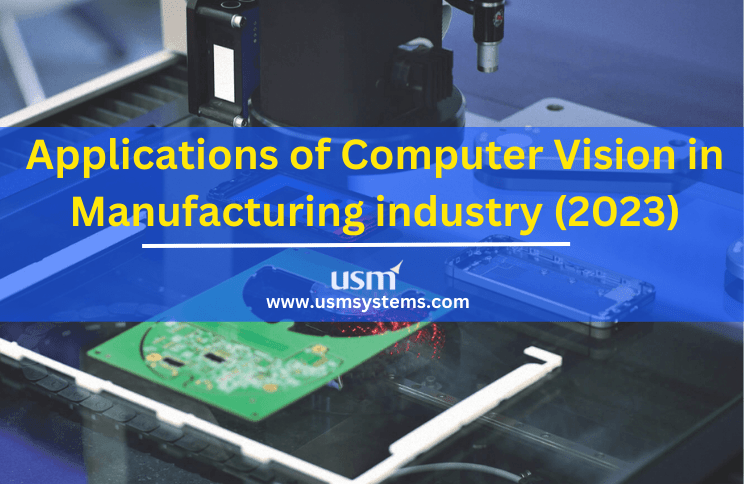Computer vision is one of the branches of artificial intelligence that instructs and equips machines to understand the visual environment. Computers can use digital images and deep learning models to accurately detect, classify, and respond to objects. The goal of computer vision is to give computer systems the ability to accurately recognize an object or person in a digital image and take the necessary action.

Recommended To Read: Top Use-Cases for Computer Vision in Manufacturing
Computer Vision Applications in Manufacturing Industry
1. Quality inspection with computer vision
One of the most important uses of machine vision in manufacturing is to automate quality inspection during the production process. Maintaining quality standards is of paramount importance in the field of manufacturing. While one can do this manually by hiring QA experts, the chances of human error are quite high and naturally limited.
2. Optimization of supply chains
Streamlining the supply chain process is beneficial for manufacturing plants to reduce costs and improve customer satisfaction. While the human intervention was required in the past to monitor various parts of the supply chain process, advances in the field of computer vision have brought about a change in this regard.
3. Equipment Monitoring and Predictive Maintenance
Machine vision technologies are used to identify such changes in manufacturing equipment considerably more effectively than human observations are. Even in tiny machine parts, these technologies have been utilised to detect flaws in real-time. This enables the prompt identification and repair of any parts that may otherwise have caused the manufacturing process to stall.
Deep learning applications is used for fault diagnosis, leak detection, and forecasting of industrial equipment. Machine learning techniques have been used to develop intelligent fault diagnosis systems.
4. Maintenance of assets
The devil is in the details, both when it comes to identifying manufacturing defects and anomalies in industrial assets. The good news is that computer vision systems, enhanced with machine learning automation for anomaly detection, can deal with detail quite well. In fact, these tools can probe industrial machinery with cameras, infrared thermography, and other types of sensors to detect any deviations that could be a sign of malfunction and predict upcoming failures before they actually occur.
5. Detection of product defects
The use of machine vision in manufacturing can help detect defective products with remarkable ease. It can be difficult to manually identify the smallest defects in products during the manufacturing process. In addition, the delivery of an order containing a defective product can not only lead to increased production costs but also customer dissatisfaction.
6. Staff safety
Machine vision can be a guardian angel for both machines and, more importantly, humans, as predictive maintenance allows manufacturing companies to repair machinery in advance, thus avoiding risky situations. Additionally, it can be used to constantly monitor complex manufacturing operations in a variety of industrial settings.
Recommended To Read: Artificial Intelligence Reshaping the Automotive Industry
7. Real-time barcode reading
Today, most products come with a barcode for easy identification. Manufacturing companies must ensure that products have accurately printed barcodes before they are shipped to market. Manual verification of each barcode is time-consuming, not to mention the associated labor costs. Despite these manual checks, errors are inevitable.
8. Packing instructions
Maintaining packaging standards is vital to ensure the safety of finished products. CV is very effective in ensuring that all product packaging is correct and that there are no errors in the packaging that could cause product recall. In some companies, there is a requirement to count the number of items before packing them. In industries like pharmaceuticals and retail, relying on these items can get finicky with lots of mistakes.
Recommended To Read: Importance of AI Technology in Manufacturing Industry
9. Inventory Management
Any manufacturing unit needs to maintain adequate inventories to ensure continuous manufacturing processes. Through the use of machine vision, thousands of companies around the world proactively track inventory status. This system also helps the respective managers to receive alerts for unavailability or out-of-stock. When operating with large manufacturing units, artificial vision facilitates the location of stock.
Benefits of Artificial Vision in Manufacturing
1. Eliminate errors from quality control processes: A number of minor issues that can arise during manufacturing processes can be easily overlooked by a worker. Controlling them is essential as the output can suffer from a lack of quality. Also, if the problem gets out of hand, it can lead to fines and reputational damage.
2. Strengthens security in the manufacturing environment: Companies can use machine vision to support security operations. The additions of facial recognition systems and contactless security systems are among the many potential measures. Access is only allowed to those with valid authorization. Automated algorithms can support quality assurance and security precautions.
Recommended To Read: Artificial intelligence in business intelligence
3. Cost optimization – Higher productivity combined with less machine downtime due to automation and CV-based maintenance results in lower overall operating costs.
Conclusion
Computer vision in manufacturing, along with many other technologies involved in the digitization of industrial processes, has proven to be a valuable ally for manufacturing companies, resulting in significant cost reductions, higher output and quality, precision superior, and greater security of the personnel. Obviously, organizations should not take the adoption of computer vision lightly, as its actual implementation could prove more complicated than expected.
However, with the right investments, training programs, workflow harmonization initiatives, and use case identification, machine vision-powered machines will fuel industrial manufacturing just as the love of beauty spurred artisans. to create their artisan products in the past centuries.
